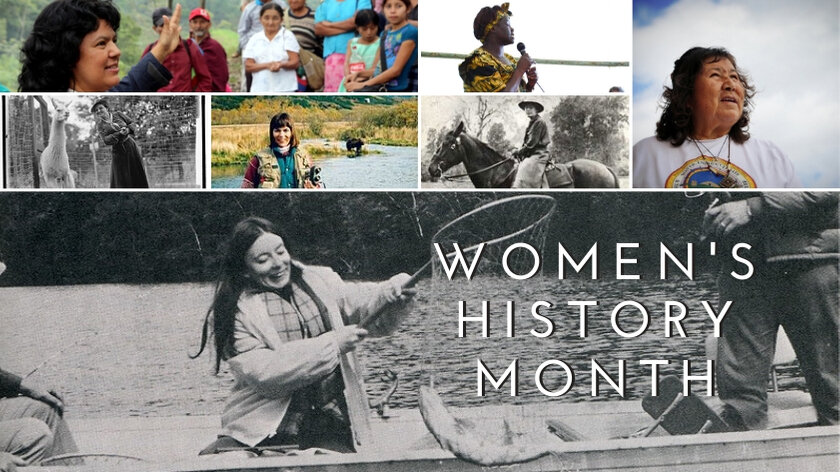Many stories go untold and some of these you might not have heard about. Learn about 8 women who changed the narrative by advocating for conservation and the protection of their land, water, and wildlife.
Mary Seacole – Travel Memoirist
Mary Seacole, aka Mother Seacole was a novelist and avid traveler in the late 1800s. Born in Jamaica, she took to travelling through the Bahamas, Haiti, England, and Cuba. She collected knowledge about local plants used for herbal medicines. She later wrote the book ‘Wonderful Adventures of Mrs. Seacole in Many Lands”, the first travel memoir ever published by a black woman.
Clare Marie Hodges – National Park Service ranger
Formerly a schoolteacher, Clare changed career paths at the end of WWI and became the first female National Park Service Ranger. She was known to be fearless and independent, seen riding horseback overnight from each ends of the park to deliver gate receipts. She was the only female park ranger for the next 30 years.
Harriet Chalmers Adams – National Geographic Society
Harriet was a world explorer who was driven by curiosity and a goal to write about the world around her. Her love for travel began after a trip to Mexico. From then on, she explored all South America, with a focus on getting off the beaten path and meeting with 20 indigenous tribes. She was not only a strong writer, but she was a photographer who would contribute up to 30 articles for the National Geographic Society. Even though she was a key contributor to the publication, she was never offered a membership as she was a woman. She didn’t let that deter her and helped create the Society of Women Geographers in 1925.
“ “I’ve never found my sex a hinderment; never faced a difficulty, which a woman, as well as a man, could not surmount; never felt a fear of danger; never lacked courage to protect myself. I’ve been in tight places and have seen harrowing thing.” ”
Josephine Mandamin – First Nations Anishinaabe Elder and Water Walker
Josephine was a water activist who called for a need to protect and care for our water. Since 2003, she had completed 13 Water Walks around Lake Superior, whose shoreline is over 2,500 miles, and would ceremoniously carry a copper pail filled with water that contained the lake water to raise awareness and pray. Others began to hear about her Water Walks and began joining her on her protest. Her final walk started in April 2017 and there were over a thousand participants. She and a group of helpers known as The Walkers started in Minnesota and for 97 days, they traveled 3,197 miles on foot. The path they took covered the shorelines of Lake Superior, Lake Huron, Lake Erie, and so on until they reached the Labrador Sea and North Atlantic Ocean. Josephine passed away on February 22nd, 2019, at the age of 77, but she encouraged future generations to pick up the copper pail and continue sharing awareness for clean water.
Hallie M. Daggett - first woman employed by the US Forest Service
Hallie Daggett learned how to hunt, fish, ride, trap and shoot early in life, skills which served her well as the first woman employed by the Forest Service. She worked as a lookout for 15 years beginning in 1913 at Eddy's Gulch Lookout Station atop Klamath Peak in California’s Klamath National Forest. It was almost a hundred years later before the Forest Service appointed their first female chief Abigail R. Kimbell in 2007.
Berta Isabel Cáceres Flores – Hondouran human rights and environmental activist
Berta fought for her people, land, water when her government and outside corporations began building what would have been the world’s largest dam in Honduras, without the approval of the people who lived there. The project was ultimately halted by peaceful protests, local assemblies, the blocking of roads to the construction site, and citations of human rights violations by the international community. Berta was outspoken and supported by her local community but was killed by those who wished to stop the Honduran activists protesting the dam. Her legacy and impact continue today. The people of Honduras are still fighting off the project and calling for justice in Berta’s name.
Wangari Maathai - 2004 Nobel Peace Prize Winner
Professor Maathai founded The Green Belt Movement (GBM) in 1977 in response to the needs of rural Kenyan women who reported that their streams were drying up, their food supply was less secure, and they had to walk further and further to get firewood for fuel and fencing. Together, the GBM encouraged women o grow seedlings and plant trees to bind the soil, store rainwater, provide food and firewood, and receive a small monetary token for their work. The Green Belt Movement continues to expand its horizon to include community development work encompassing the arenas of environmental conservation, democracy, community empowerment and conflict resolution.
Mollie H. Beattie - first female director of U.S. Fish and Wildlife Service
Mollie Beattie was the first female director of the U.S. Fish and Wildlife Service. In her short term there from 1993 to 1996, she oversaw the reintroduction of the gray wolf into the northern Rocky Mountains and the addition of 15 national wildlife refuges. A wilderness area is named for her in the Arctic National Wildlife Refuge.
“In the long term, the economy and the environment are the same thing. If it’s unenvironmental it is uneconomical. That is the rule of nature.”
There are so many women who have made a difference for the land, water, wildlife, and their environment. Celebrate Women’s History Month by checking out additional stories of women inspiring others to speak up for what they care about.
Resources & Additional Stories
https://www.wilderness.org/articles/article/11-women-who-made-wilderness-history
https://www.adventure-journal.com/2016/01/harriet-chalmers-adams-the-original-adventure-lebrity/
https://www.wxpr.org/post/water-walker-josephine-mandamin#stream/0
https://www.mnn.com/earth-matters/wilderness-resources/stories/women-who-changed-way-we-see-nature
https://insidetheperimeter.ca/forces-of-nature-great-women-who-changed-science/











